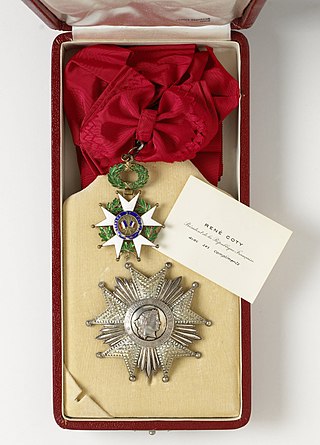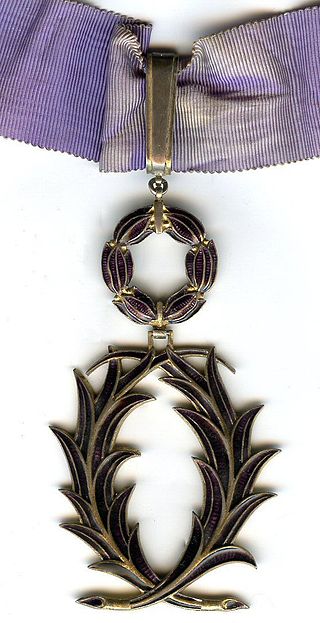
The National Order of the Legion of Honour, formerly the Royal Order of the Legion of Honour, is the highest French order of merit, both military and civil. Established in 1802 by Napoleon Bonaparte, it has been retained by all later French governments and regimes.

The Order of Leopold is one of the three current Belgian national honorary orders of knighthood. It is the oldest and highest order of Belgium and is named in honour of its founder, King Leopold I. It consists of a military, a maritime and a civil division. The maritime division is only awarded to personnel of the merchant navy, and the military division to military personnel. The decoration was established on 11 July 1832 and is awarded by Royal order.
The Ordre des Arts et des Lettres is an order of France established on 2 May 1957 by the Minister of Culture. Its supplementary status to the Ordre national du Mérite was confirmed by President Charles de Gaulle in 1963. Its purpose is the recognition of significant contributions to the arts, literature, or the propagation of these fields.

The Royal and Military Order of Saint Louis is a dynastic order of chivalry founded 5 April 1693 by King Louis XIV, named after Saint Louis. It was intended as a reward for exceptional officers, notable as the first decoration that could be granted to non-nobles. By the authorities of the French Republic, it is considered a predecessor of the Legion of Honour, with which it shares the red ribbon.
Commander, or Knight Commander, is a title of honor prevalent in chivalric orders and fraternal orders.
Anne Boquet is a retired French senior civil servant. She is the first and only woman to have been High Commissioner in French Polynesia to date.

The Order of La Pléiade is an honorary order of the Organisation internationale de la Francophonie. It recognizes people who particularly distinguished themselves in the service of its ideals of cooperation and friendship, promoting the role of the French language in their own countries or in the world. It was created in 1976 on initiative of the Assemblée parlementaire de la Francophonie.

The Ordre des Palmes académiques is a national order bestowed by the French Republic on distinguished academics and teachers and for valuable service to universities, education and science. Originally established in 1808 by Emperor Napoleon as a decoration to honour eminent members of the University of Paris, it was changed into its current form as an order of merit on 4 October 1955 by President René Coty, making it one of the oldest civil honours bestowed by the French Republic.

The Ordre de l'Étoile d'Anjouan was a French colonial order of knighthood founded in 1874.

The Order of Agricultural Merit is an order of merit bestowed by the French Republic for outstanding contributions to agriculture. When it was created in 1883, it was second in importance only to the Legion of Honour within the French order of precedence.

Benoît Puga is a general in the French Army and the Grand Chancellor of the National Order of the Legion of Honour and the National Order of Merit.

The National Order of the Lion is the highest order of Senegal.

The Ordre national du Mérite is a French order of merit with membership awarded by the President of the French Republic, founded on 3 December 1963 by President Charles de Gaulle. The reason for the order's establishment was twofold: to replace the large number of ministerial orders previously awarded by the ministries; and to create an award that can be awarded at a lower level than the Legion of Honour, which is generally reserved for French citizens. It comprises about 185,000 members; 306,000 members have been admitted or promoted in 50 years.

Admiral Georges Cabanier was a French Naval Officer and Admiral, in addition to Grand Chancellor of the Legion of Honour.
Jacques Lefort was a Général de corps d'armée of the French Army and Commandant of the Foreign Legion.
The Order of Ivory Merit is the second highest honorary order of the Ivory Coast created in 1970, and is intended to reward distinguished merits acquired in a public, civil, military or private function.

The Ordre du Mérite combattant was a ministerial order of merit of France created on 14 September 1953 to reward individuals who distinguished themselves by their service and dedication in the management of the moral and material interests of veterans and war victims. These individuals' applicable service could be working in the Ministry of Veterans and War Victims or for organizations and associations who work for veterans. The order was administered and awarded the Ministry of Veterans and War Victims.
Matahi Brothers was a French Polynesian banker and company director, who was managing director of the SOCREDO bank from 2017 to 2022.
Dominique Marghem is a French medical doctor, who, who has spent his career working in French Polynesia. From 2010 to 2012 he served as director of French Polynesia's health department.













